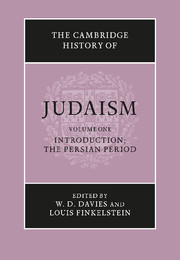Book contents
- Frontmatter
- INTRODUCTION
- THE PERSIAN PERIOD
- 4 The Persian empire and the political and social history of Palestine in the Persian period
- 5 The archeology of Persian palestine
- 6 Hebrew and Aramaic in the Persian period
- 7 The Jewish community in Palestine in the Persian period
- 8 Prophecy and Psalms in the Persian period
- 9 Wisdom literature in the Persian period
- 10 Jewish religious life in the Persian period
- 11 Persian religion in the Achemenid age
- 12 Iranian influence on Judaism: first century B.C.E. to second century C.E.
- 13 The Diaspora
- Bibliographies
- Chronological Table
- Index
- References
6 - Hebrew and Aramaic in the Persian period
from THE PERSIAN PERIOD
Published online by Cambridge University Press: 28 March 2008
- Frontmatter
- INTRODUCTION
- THE PERSIAN PERIOD
- 4 The Persian empire and the political and social history of Palestine in the Persian period
- 5 The archeology of Persian palestine
- 6 Hebrew and Aramaic in the Persian period
- 7 The Jewish community in Palestine in the Persian period
- 8 Prophecy and Psalms in the Persian period
- 9 Wisdom literature in the Persian period
- 10 Jewish religious life in the Persian period
- 11 Persian religion in the Achemenid age
- 12 Iranian influence on Judaism: first century B.C.E. to second century C.E.
- 13 The Diaspora
- Bibliographies
- Chronological Table
- Index
- References
Summary
Hebrew and Aramaic were the two main languages in use among the Jews during the Persian period. They are both north-west Semitic languages but while Hebrew belongs, together with Phoenician, Moabite and Ammonite, to the Canaanite branch, Aramaic forms a branch apart. Hebrew was the native tongue of both Judah and Israel during the monarchic period, although there were dialect distinctions between the north and the south. Among the Canaanite dialects, Moabite seems to be particularly close to Hebrew, but our documentation for these dialects is relatively meagre. After the dissolution of the northern kingdom, speakers of other languages were introduced into various parts of the country to replace exiled Israelites.
Aramaic was the language solely of the Arameans gathered at first in tribal units and then in city-states and petty kingdoms in Syria and Mesopotamia. In the eighth century it became the lingua franca of the Assyrian empire, especially in the provinces ‘Beyond the River’ (Euphrates). The complicated cuneiform writing system of the Assyrians was replaced by the relatively simpler alphabetic Aramaic script, at first in those provinces where alphabetic writing was already in use and then in Assyria proper. Aramaic was introduced for commercial and administrative purposes and Aramaic scribes were employed alongside Assyrian ones, since expansion to the west brought about the absorption of many Aramaic speakers into Assyria proper. Aramaic was used for diplomatic purposes in lands outside the Assyrian empire (see, for example, 2 Kings 18: 26, Isa. 36: 11) and subsequently also for communication within the Assyro-Babylonian area (KAI 233).
- Type
- Chapter
- Information
- The Cambridge History of Judaism , pp. 115 - 129Publisher: Cambridge University PressPrint publication year: 1984
References
- 27
- Cited by

